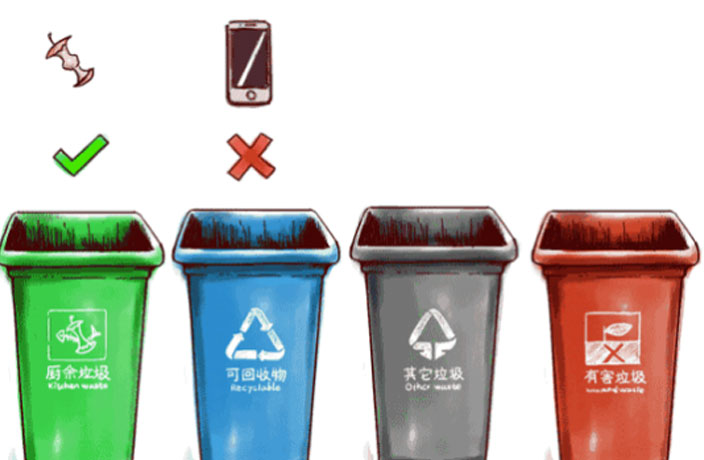
With trash sorting regulations taking effect across China, we’ve concluded a general guide on how to deal with rubbish under the rules. Improperly sorted trash could result in punishments for individuals and enterprises, with fines for offenders varying by city and province. Below are the four main trash sorting categories.
1. Recyclable Waste
This category covers anything which can be recycled or reused.
Examples: glass, metals, plastics, paper and articles made of paper, textiles (纺织品), furniture, plastic bottles, basins and buckets.
Bin color: Typically blue
Note: These items must be cleaned before being placed in the recycle bin.
2. Hazardous Waste
Hazardous waste, as the name suggests, includes any waste that poses a direct or potential risk to human health or the natural environment.
Examples: used batteries, light bulbs, expired (过期的) medicines, paint, mercury thermometers (水银温度计) and pesticides (杀虫剂)
Bin color: Typically red
3. Household Food Waste
Household food waste—which is translated to “wet trash” in Chinese—refers to food leftovers, rotten food, pet food, fruit peels, remains of TCM herbs and flowers. This category covers anything perishable (易腐烂的) or compostable(可用作堆肥的).
Examples: leftovers, vegetables, used tea leaves, egg shells, fruit peels, soup leftovers and bones.
Bin color: Differs by city, but kitchen waste bins are usually brown (Shanghai) or green (Shenzhen, Beijing)
4. Residual Waste
The definition of residual waste can be a little confusing, but basically refers to anything that is not already listed above.
Examples: bags, contaminated paper (污损纸张), dirty plastic bags, diapers (尿布), dirt, cigarette butts (烟蒂), paper and plastic takeout boxes, broken flower pots and bowls, wallpaper.
Bin color: Usually gray or black
本时文内容由奇速英语国际教育研究院原创编写,未经书面授权,禁止复制和任何商业用途,版权所有,侵权必究!(作者投稿及时文阅读定制请联系微信:18980471698)1.What should you do before placing items into the blue bin?
A Dry them up.
B Keep them safe.
C Clean them up.
D Wrap them up.
解析:选C。C细节理解题。根据Recyclable Waste部分的“Bin color: Typically blue”“Note: These items must be cleaned before being placed in the recycle bin”可知,可回收垃圾的垃圾桶是蓝色,在回收之前需要把垃圾处理干净。故选C。
2.What is special about “Household Food Waste”?
A It doesn’t include industry waste.
B The bin color differs by city.
C Some waste can be recycled.
D It’s wet most of the time.
解析:选B。B细节理解题。根据全文内容及Household Food Waste的最后一句“Bin color: Differs by city, but kitchen waste bins are usually brown (Shanghai) or green (Shenzhen, Beijing)”可知,厨余垃圾的垃圾桶有两种颜色,其他垃圾的垃圾桶都只有一种颜色。故选B。
3.Which of the following should be put into a green bin?
A Clothes.
B Batteries.
C Bones.
D Wallpaper.
解析:选C。C细节理解题。根据green bin定位到Household Food Waste,可知骨头属于厨余垃圾。故选C。
4.What do the underlined words “Residual Waste” mean?
A Kitchen waste.
B Dangerous waste.
C Other waste.
D Returnable waste.
解析:选C。C词义猜测题。根据最后一部分对Residual Waste的定义“refers to anything that is not already listed above”可知,除了以上列出的垃圾以外的垃圾,即其他垃圾。故选C。